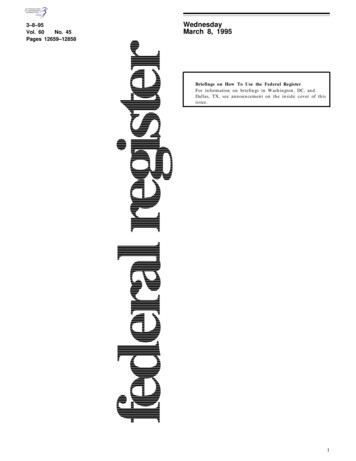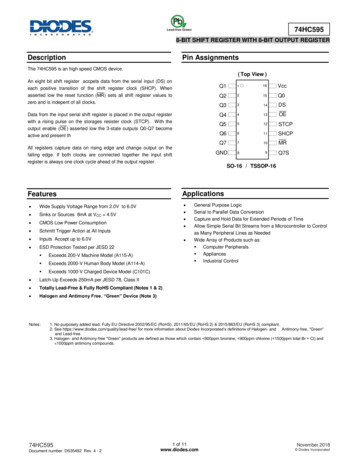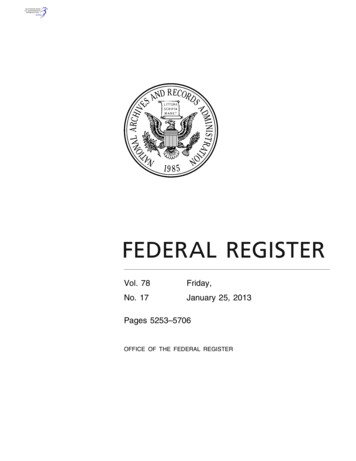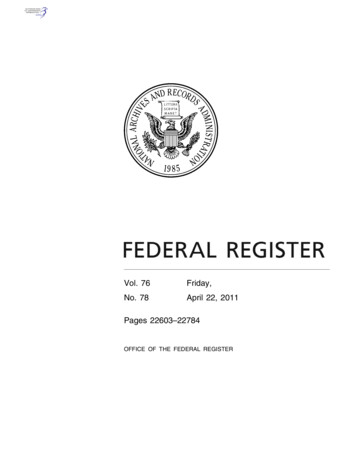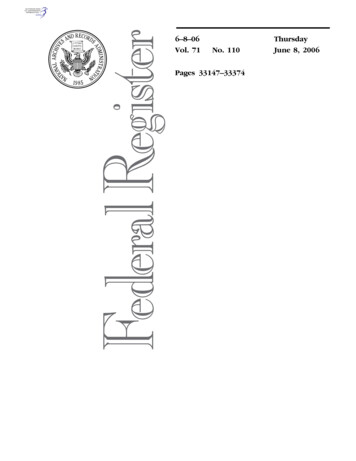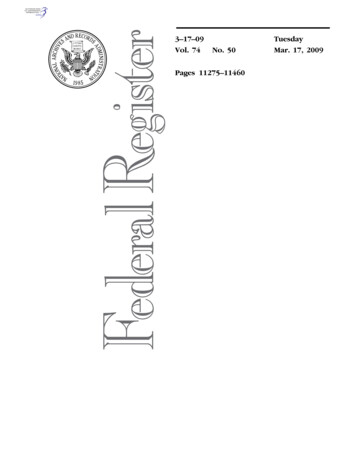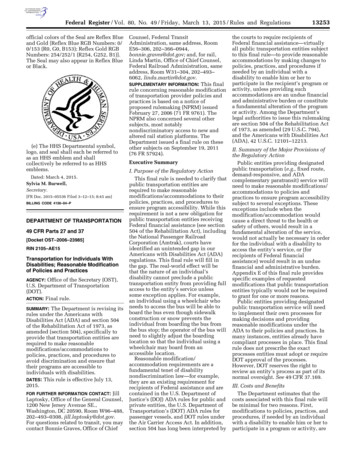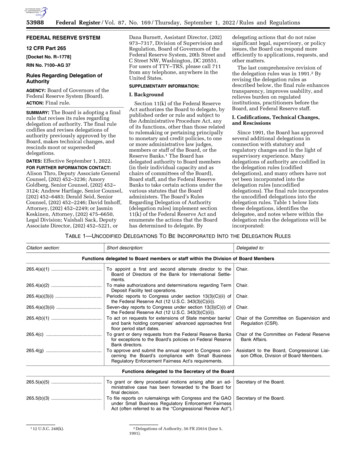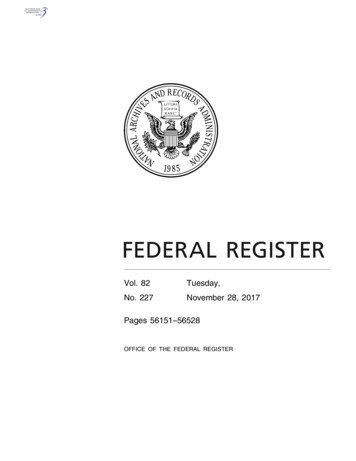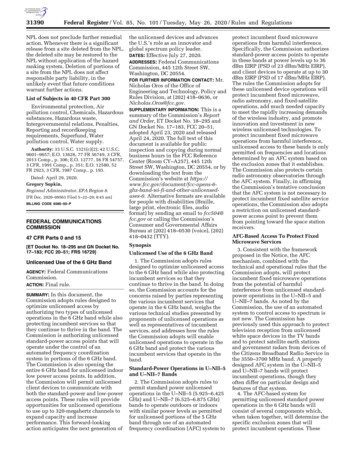
Transcription
31390Federal Register / Vol. 85, No. 101 / Tuesday, May 26, 2020 / Rules and RegulationsNPL does not preclude further remedialaction. Whenever there is a significantrelease from a site deleted from the NPL,the deleted site may be restored to theNPL without application of the hazardranking system. Deletion of portions ofa site from the NPL does not affectresponsible party liability, in theunlikely event that future conditionswarrant further actions.List of Subjects in 40 CFR Part 300Environmental protection, Airpollution control, Chemicals, Hazardoussubstances, Hazardous waste,Intergovernmental relations, Penalties,Reporting and recordkeepingrequirements, Superfund, Waterpollution control, Water supply.Authority: 33 U.S.C. 1321(c)(2); 42 U.S.C.9601–9657; E.O. 13626, 77 FR 56749, 3 CFR,2013 Comp., p. 306; E.O. 12777, 56 FR 54757,3 CFR, 1991 Comp., p. 351; E.O. 12580, 52FR 2923, 3 CFR, 1987 Comp., p. 193.Dated: April 29, 2020.Gregory Sopkin,Regional Administrator, EPA Region 8.[FR Doc. 2020–09563 Filed 5–22–20; 8:45 am]BILLING CODE 6560–50–PFEDERAL COMMUNICATIONSCOMMISSION47 CFR Parts 0 and 15[ET Docket No. 18–295 and GN Docket No.17–183; FCC 20–51; FRS 16729]Unlicensed Use of the 6 GHz BandFederal CommunicationsCommission.ACTION: Final rule.AGENCY:In this document, theCommission adopts rules designed tooptimize unlicensed access byauthorizing two types of unlicensedoperations in the 6 GHz band while alsoprotecting incumbent services so thatthey continue to thrive in the band. TheCommission is authorizing unlicensedstandard-power access points that willoperate under the control of anautomated frequency coordinationsystem in portions of the 6 GHz band.The Commission is also opening theentire 6 GHz band for unlicensed indoorlow power access points. In addition,the Commission will permit unlicensedclient devices to communicate withboth the standard-power and low-poweraccess points. These rules will provideopportunities for unlicensed operationsto use up to 320-megahertz channels toexpand capacity and increaseperformance. This forward-lookingaction anticipates the next generation ofSUMMARY:VerDate Sep 11 201416:12 May 22, 2020Jkt 250001the unlicensed devices and advancesthe U.S.’s role as an innovator andglobal spectrum policy leader.DATES: Effective July 27, 2020.ADDRESSES: Federal CommunicationsCommission, 445 12th Street SW,Washington, DC 20554.FOR FURTHER INFORMATION CONTACT: Mr.Nicholas Oros of the Office ofEngineering and Technology, Policy andRules Division, at (202) 418–0636, orNicholas.Oros@fcc.gov.SUPPLEMENTARY INFORMATION: This is asummary of the Commission’s Reportand Order, ET Docket No. 18–295 andGN Docket No. 17–183, FCC 20–51,adopted April 23, 2020 and releasedApril 24, 2020. The full text of thisdocument is available for publicinspection and copying during normalbusiness hours in the FCC ReferenceCenter (Room CY–A257), 445 12thStreet SW, Washington, DC 20554, or bydownloading the text from theCommission’s website at i-fi-and-other-unlicenseduses-0. Alternative formats are availablefor people with disabilities (Braille,large print, electronic files, audioformat) by sending an email to fcc504@fcc.gov or calling the Commission’sConsumer and Governmental AffairsBureau at (202) 418–0530 (voice), (202)418–0432 (TTY).SynopsisUnlicensed Use of the 6 GHz Band1. The Commission adopts rulesdesigned to optimize unlicensed accessto the 6 GHz band while also protectingincumbent services so that theycontinue to thrive in the band. In doingso, the Commission accounts for theconcerns raised by parties representingthe various incumbent services thatoperate in the 6 GHz band, weighs thevarious technical studies presented byproponents of unlicensed operations aswell as representatives of incumbentservices, and addresses how the rulesthe Commission adopts will enableunlicensed operations to operate in the6 GHz band and protect the variousincumbent services that operate in theband.Standard-Power Operations in U–NII–5and U–NII–7 Bands2. The Commission adopts rules topermit standard power unlicensedoperations in the U–NII–5 (5.925–6.425GHz) and U–NII–7 (6.525–6.875 GHz)bands to operate outdoors or indoorswith similar power levels as permittedfor unlicensed portions of the 5 GHzband through use of an automatedfrequency coordination (AFC) system toPO 00000Frm 00034Fmt 4700Sfmt 4700protect incumbent fixed microwaveoperations from harmful interference.Specifically, the Commission authorizesstandard-power access points to operatein these bands at power levels up to 36dBm EIRP (PSD of 23 dBm/MHz EIRP),and client devices to operate at up to 30dBm EIRP (PSD of 17 dBm/MHz EIRP).The rules the Commission adopts forthese unlicensed device operations willprotect incumbent fixed microwave,radio astronomy, and fixed-satelliteoperations, add much needed capacityto meet the rapidly increasing demandsof the wireless industry, and promoteinnovation and investment in newwireless unlicensed technologies. Toprotect incumbent fixed microwaveoperations from harmful interference,unlicensed access to these bands is onlypermitted on frequencies and locationsdetermined by an AFC system based onthe exclusion zones that it establishes.The Commission also protects certainradio astronomy observatories throughthe AFC system. Finally, in affirmingthe Commission’s tentative conclusionthat the AFC system is not necessary toprotect incumbent fixed satellite serviceoperations, the Commission also adoptsa restriction on unlicensed standardpower access point to prevent themfrom pointing toward the space stationreceivers.AFC-Based Access To Protect FixedMicrowave Services3. Consistent with the frameworkproposed in the Notice, the AFCmechanism, combined with thetechnical and operational rules that theCommission adopts, will protectincumbent fixed microwave operationsfrom the potential of harmfulinterference from unlicensed standardpower operations in the U–NII–5 andU–NII–7 bands. As noted by theCommission, the use of an automatedsystem to control access to spectrum isnot new. The Commission haspreviously used this approach to protecttelevision reception from unlicensedwhite space devices in the TV bandsand to protect satellite earth stationsand government radars from devices ofthe Citizens Broadband Radio Service inthe 3550–3700 MHz band. A properlydesigned AFC system in the U–NII–5and U–NII–7 bands will protectincumbent operations, though theyoften differ on particular design andfeatures of that system.4. The AFC-based system forpermitting unlicensed standard poweroperations in the 6 GHz bands willconsist of several components which,when taken together, will determine thespecific exclusion zones that willprotect incumbent operations. TheseE:\FR\FM\26MYR1.SGM26MYR1
Federal Register / Vol. 85, No. 101 / Tuesday, May 26, 2020 / Rules and Regulationscomponents include (1) the framework,design, and operation of AFC system; (2)the operational requirements that theCommission establishes regardingstandard-power access points (e.g.,geolocation capabilities, antenna-relatedrestrictions); and (3) the interferenceprotection parameters that protect theincumbent fixed service operations.The AFC System Framework andDatabase5. Centralized approach. TheCommission requires the AFC to use acentralized model where each standardpower access point remotely accesses anAFC to obtain a list of availablefrequency ranges in which it ispermitted to operate and the maximumpermissible power in each frequencyrange. This is consistent with thecentralized model the Commission hasemployed in other contexts, willfacilitate Commission oversight of AFCoperations, and reduces designcomplexity. Because the Commission isconcerned that allowing botharchitectures (centralized and decentralized) could create problematic orunforeseen complications in operationalmanagement of AFC systems anddevices and thereby could delayunlicensed deployment in this band, itdeclines to permit use of a dual AFCarchitecture as some parties havesuggested.6. Use of ULS for information onincumbent operations. the Commissionrequires that the AFC system rely on theCommission’s Universal LicensingSystem (ULS) for fixed microwave linkdata when calculating and establishingthe exclusion zones to protect thosemicrowave links from harmfulinterference. The ULS is the officiallicensing database for microwave linksin the U–NII–5 and U–NII–7 bands andcontains extensive technical data forsite-based licenses including transmitterand receiver locations, frequencies,bandwidths, polarizations, transmitterEIRP, antenna height, and the make andmodel of the antenna and equipmentused. Thus, the ULS contains theinformation necessary for AFC systemsto protect fixed service links. To ensurethat AFC systems have the most recentinformation on fixed service links, theCommission requires AFC systems todownload the database on a daily basis.7. The Commission recognizes theconcerns of some parties thatinformation used by the AFC systemsmust be accurate and up-to-date, andnotes that there may currently be someinaccurate or incomplete data in theULS database. Because ULS is theofficial Commission compendium oflicense records, licensees are obligatedVerDate Sep 11 201416:12 May 22, 2020Jkt 250001under the terms of their licenses to keeptheir information filed with theCommission current and complete.Thus, licensees have the responsibility,as well as significant incentive, tomaintain the continued accuracy of datain the ULS to ensure that they areprotected from harmful interference notonly from new unlicensed devices, butalso from new fixed microwave linksthat may access the band. To the extentlicensees determine that their actualoperations differ from the Commission’slicensing records, they should modifythose records to ensure they areproperly protected from harmfulinterference from any other spectrumusers, and the Commission directs theWireless Telecommunications Bureau toissue a public notice reminding suchlicensees of the importance ofmaintaining accurate information in thatsystem.8. Microwave links may beginoperation prior to obtaining a license solong as certain criteria are met, such ascompleting successful frequencycoordination and filing an applicationthat appears in the ULS as pending.Because such a filing may indicate thata new station is operational, or soonwill be, the Commission requires theAFC system to protect pending as wellas granted facilities. In addition,temporary fixed microwave links maybe authorized by a blanketauthorization, in which case thelicensee is not required to obtainapproval from the Commission prior tooperating at specific locations or reportthe technical details of their operationto the Commission. Because the AFCsystem must have knowledge of thelocation of temporary fixed links inorder to protect them from harmfulinterference, the Commission requiresthe operators of temporary fixed stationsto register the details of their operations(transmitter and receiver location,antenna height, antenna azimuth,antenna make and model, etc.) in theULS prior to transmission if they desireto be protected from potentiallyreceiving harmful interference fromstandard-power access points in the U–NII–5 and U–NII–7 bands. Thecapability to register temporary fixedlinks does not currently exist in theULS. That functionality will beannounced by Public Notice oncedeveloped. Because temporary fixedlinks are not mobile and intended tooperate at a specified location for up toa year, the Commission does not believethis registration requirement poses asignificant burden on licensees.9. Information on microwaveoperations in border areas near Canadaand Mexico. As required byPO 00000Frm 00035Fmt 4700Sfmt 470031391international agreements, and consistentwith actions regarding white spaces andthe CBRS, the Commission requires theAFC to protect microwave operations inCanada and Mexico near the UnitedStates border. The Commissionrecognizes that the ULS does notcontain information on microwaveoperations in these countries. TheCommission therefore intends to workwith the governments of Canada andMexico to obtain information onmicrowave systems in those countriesand a method for providing it to AFCoperators for incorporation into theirsystems.10. Information on location andantenna height of standard-poweraccess points. The AFC system also willmake use of data concerning thelocation and antenna height of standardpower access points when calculatingthe availability of frequencies andchannels of operations. TheCommission establishes particularoperational requirements for accesspoints that ensure the accuracy of thisdata.11. Use of specified interferenceprotection parameters. The AFC systemwill apply the specified interferenceprotection parameters established inthis Order to protect fixed microwaveoperations from harmful interference.These include use of specifiedpropagation models and a conservativeinterference protection criterion whencalculating exclusion zones, and themethodology for addressing adjacentchannel operations.12. Determining frequency andchannel availability based onunlicensed device power levels. TheCommission requires that the AFC havethe capability to determine frequencyavailability at the maximum permissiblepower of 36 dBm for standard-poweraccess points, as well as at lower powerlevels. Because the minimum requiredseparation distance from a fixed servicereceiver, among other factors, is afunction of the access point power,lower power devices do not have tomeet as large a separation distance toprovide the same level of protection ashigher power devices. This means thatmore spectrum may be available foraccess points that operate with powerlevels below the maximum, especiallyin congested areas where spectrum ismore heavily used by the fixedmicrowave services. This action isconsistent with the Commission’s whitespace rules in which white spacedevices operating at power levels lessthan the maximum have shorterrequired separation distances fromprotected services, and the white spacedatabase provides devices with a list ofE:\FR\FM\26MYR1.SGM26MYR1
31392Federal Register / Vol. 85, No. 101 / Tuesday, May 26, 2020 / Rules and Regulationsavailable frequencies and the maximumpermissible power on each.13. The Commission requires that theAFC system be capable of determiningfrequency availability in steps of nogreater than 3 dB below the maximum36 dBm permissible EIRP, down to aminimum level of 21 dBm. TheCommission believes 3 dB is anappropriate step size because it is largeenough to be significant (i.e. a factor oftwo) and will allow the AFC todetermine frequency availability atmultiple power levels so a device canselect its optimum frequency and powerlevel combination. The Commission’srequirement that an AFC only considerpower levels as low as 21 dBm ispredicated on the expectation thatoutdoor access points will generallyoperate at the higher power levels tomaximize coverage area or throughputor both. However, because certainsituations or applications may not needthat much power, there may be a needfor AFCs to evaluate additional powerlevels. The Commission will notpreclude AFC operators fromdetermining frequency availability atadditional power levels, e.g., below 21dBm or in smaller step sizes; it simplyestablishes minimum AFC performancerequirements. Consistent with the whitespace rules, the AFC will provide a listof available frequencies and powerlevels to standard-power access pointsbut will not select the frequency orcontrol the power level of a device.Rather, each access point will select itsoperating frequency and power levelfrom the list provided by the AFC.Operational Requirements for AccessPoints14. The AFC system requires adevice’s geographic coordinates—alongwith the accuracy of those coordinates—and the device’s antenna height aboveground, in order to determine whichfrequencies are available for use at itslocation.15. Incorporated geo-location. TheCommission requires all standard-poweraccess points to include a geo-locationcapability to determine their geographiccoordinates, rather than relying on aprofessional installer to determine them.Additionally, an incorporated geolocation capability provides a means fora device to automatically re-establish itscoordinates if they are lost or altereddue to a power outage or equipmentreboot.16. The Commission requires adevice’s geo-location capability todetermine its location uncertainty andreport it to the AFC system, which willuse this information to determine theminimum required separation distancesVerDate Sep 11 201416:12 May 22, 2020Jkt 250001from fixed service receivers. TheCommission also requires that it bedetermined, in meters, with 95%confidence level, which is consistentwith the rules for white space deviceswhich operate with similar geo-locationrequirements to those the Commissionadopts for AFC controlled standardpower access points. The Commission’sexperiences with this rule confirms thatit reliably ensures protection againstharmful interference, at reasonable cost.17. The Commission recognizes thatgeo-location technologies such as GPSdo not work at locations where satellitesignals are blocked by obstructions suchas tall buildings and trees, or deepwithin buildings. To ensure thatstandard power access points canaccurately determine their coordinatesand provide them to the AFC in thesesituations, without the need forprofessional installation, theCommission provides additionalflexibility for manufacturers and deviceoperators by making provisions forstandard-power access points thatoperate in locations where anincorporated geo-location capabilitymay not work. The Commission allowsstandard-power access points to obtaintheir geographic coordinates through anexternal geo-location source when theyare used at locations where an internalgeo-location capability does notfunction. The Commission also allowsan external geo-location source to beconnected to an access point througheither a wired or a wireless connectionand will allow a single geo-locationsource to provide location informationto multiple access points. TheCommission requires that an externalgeo-location source be connected to anaccess point using a secure connectionto ensure that only an external geolocation source approved for use with adevice provides geographic coordinatesto that device. Additionally, theCommission allows the use of extendercables to connect a remote receiveantenna to a geo-location receiverwithin a fixed device. In cases whereequipment uses a remote geo-locationsource, the separation distance betweenthe access point transmit antenna andgeo-location source must be included inthe location uncertainty reported to theAFC system. This requirement will beenforced through the equipmentcertification process. Based on theCommission’s experience, it believesthese provisions will increase themanufacturers’ flexibility to developdevices that can be used in a widevariety of locations while ensuring thatdevices accurately determine theirlocation and report it to the AFC toPO 00000Frm 00036Fmt 4700Sfmt 4700prevent harmful interference toprotected services.18. Considering the geo-locationrequirements, the Commission is notrequiring professional installation. It isnot necessary because manufacturerscan incorporate a variety of locationtechnologies into their devices; many ofthese, such as GPS, are widely availableat low cost. Further, requiringprofessional installation of all standardpower access points would beburdensome and that requiring devicesto incorporate automatic geo-locationwill ensure that the informationprovided to the AFC system is accurate.19. Antenna height above ground. Forthe AFC to accurately calculateexclusion zones to protect fixed servicereceivers, it requires the antenna heightabove ground of a standard-poweraccess point. Consistent with the rulesfor white space devices, theCommission permits this information tobe provided to the AFC eitherautomatically by the device, ormanually by the installer or operator ofthe device but does not require it to bedetermined by a professional installer.20. Because automated geo-locationmethods such as GPS may notaccurately provide height information inall cases, the Commission allows adevice installer to manually determinethe antenna height above ground andprovide it to the AFC. As theCommission notes with respect to whitespace devices, installers with simplemeasuring equipment should be able toaccurately determine antenna heightabove ground. However, becauseimprovements in technology in thefuture could enable devices toautomatically determine their antennaheight above ground with moreprecision, there is also the option forstandard-power access points toautomatically do so. Industry groups areexpected to work on developingmethods for automatic heightdetermination that could be used forstandard-power access points or otherapplications where the antenna heightabove ground must be known.21. Frequency availability re-checkinterval. The Commission requires astandard-power access point to contactan AFC system at least once per day toobtain the latest list of availablefrequencies at its location. Once per dayis an appropriate re-check intervalbecause the ULS, from which the AFCsystem will obtain data, is updated ona daily basis. The Commission disagreeswith suggestions that of a 30-day recheck interval be instituted. While thelikelihood is low that a new microwavelink will become operational on anygiven day at a given location, when 6E:\FR\FM\26MYR1.SGM26MYR1
Federal Register / Vol. 85, No. 101 / Tuesday, May 26, 2020 / Rules and RegulationsGHz devices are widely deployed therewill be situations where new microwavelinks are licensed in the vicinity of cochannel standard-power access points.To ensure that an unlicensed devicequickly ceases operation on a frequencythat becomes licensed for a microwavelink near its location, standard-poweraccess points are required to re-checktheir frequency availability on a dailybasis, i.e., the same as the ULS updateinterval.22. The Commission recognizes thatthere may be situations when an AFCsystem is temporarily unavailable due toa sustained power loss, an internetoutage, or other circumstances thatdisrupt a device’s ability to contact anAFC system. Consistent with theCommission’s actions in otherproceedings, an access point that cannotcontact the AFC system during anygiven day is permitted to continueoperating until 11:59 p.m. of thefollowing day at which time it mustcease operations until it re-establishescontact with the AFC system and reverifies its list of available frequencies.The Commission does not believe thatais one-day grace period is not likely toresult in harmful interference to fixedservice links because an access pointbeing unable to contact the AFC systemfor a day is likely to be a relativelyinfrequent occurrence, and theprobability that it will occur at the sametime in the same place where a newmicrowave link commences operation islow.Designating AFC Operators23. Operator approval and systemcertification process. Consistent withthe Commission’s actions regardingwhite spaces and the CBRS, theCommission directs the Chief of theOffice of Engineering and Technology(OET) to designate AFC systemoperators and oversee operation of theirsystems.24. OET will designate AFC operatorsusing a multi-stage review processsimilar to that it used for designatingwhite space database and SASadministrators. As the first step, OETwill issue a public notice invitingprospective AFC system operators tosubmit proposals describing how theirsystems would comply with allCommission AFC rules. The public willhave an opportunity to review andcomment on these AFC systemproposals. OET will conditionallyapprove applicants that demonstratethat their proposed systems wouldcomply with all AFC requirements.Applicants that receive a conditionalapproval will then be required toprovide a test system that will be subjectVerDate Sep 11 201416:12 May 22, 2020Jkt 250001to a public trial period to provideinterested parties an opportunity tocheck that it provides accurate results.This trial period will include thoroughtesting, both in a controlledenvironment (e.g., lab testing) andthrough demonstration projects (e.g.,field testing).25. The Commission encouragesformation of a multi-stakeholder groupthat will address issues specific totechnical and operational issuesassociated with the AFC system, andintends to work with industrystakeholder groups as necessary todevelop appropriate procedures forthoroughly testing AFC systems prior touse. The Commission will not grantfinal approval for an AFC systemoperator to begin providing service untilafter the operator satisfactorilydemonstrates that standard-poweraccess points can operate under thecontrol of its system without causingharmful interference to fixed wirelessservices.26. Multiple AFC Operators. Asproposed in the Notice and consistentwith commenters’ support and existingrules for white spaces and CBRSmultiple AFC operators may bedesignated. As the Commissionpreviously noted in regard to whitespaces databases, this would prevent asingle party from obtaining monopolycontrol over the AFC systems, couldprovide an incentive for AFC systemoperators to provide additional servicesbeyond those required by the rules, andis more likely to result in lower costs toconsumers.27. The Commission permits AFCfunctions, such as a data repository,registration, and query services, to besplit among multiple entities, as is donefor white spaces and the CBRS. Noparties commented on this specificissue. This approach will allow greaterflexibility in AFC system design andpotential cost savings by allowingmultiple operators to share the costs ofrunning parts of an AFC systems.However, to ensure that the Commissioncan effectively oversee the AFC systemoperation, it requires that entitiesdesignated as AFC system operators beheld accountable for all aspects ofsystem administration, including anyfunctions performed by third parties.28. Term of AFC Designation. Toensure a stable operating environmentfor standard-power access points andconsistent with both the white spaceand CBRS rules, the Commission adoptsa five-year term which, at theCommission’s discretion, may berenewed. Similar to the requirements forthe white space database and SASadministrators, in the event an AFCPO 00000Frm 00037Fmt 4700Sfmt 470031393system operator does not wish tocontinue to provide services, or if itsterm is not renewed, the systemoperator will be required to transfer itsdatabase along with the informationnecessary to access the database toanother designated AFC system and willbe permitted to charge a reasonable feefor the transfer of this information.Transferring this information assuresoperational continuity for existingdevices; otherwise in the event an AFCdiscontinues service, devices would bedenied operating frequencies and cut-offfrom providing services until itestablished a connection to a newdatabase. This action allows that newconnection to occur automatically.29. The Commission disagrees that itwould be burdensome for an AFCoperator to transfer its registration datato another AFC system operator sincethe data that must be transferred (e.g.,location, antenna height, device FCC IDand serial number) is relatively simple.The Commission also adopts theproposal that an AFC system operatormust provide a minimum of 30 days’notice to the Commission when it plansto cease operation. Because standardpower access points must be able toaccess an AFC in order to operate, theCommission does not believe that the itshould designate AFC system operatorsthat could cease operation at any timewith no notice as that could leave userswith equipment that ceases operatingunexpectedly.30. Fees. Consistent with the rules forwhite space database and CBRS SASadministrators and as supported in therecord, the Commission permits AFCoperators to charge fees for theprovision of service. Because theCommission is allowing multiple AFCoperators to be designated, theCommission believes that competitionamong them will serve to keep feesreasonable and will allow for multiplebusiness models that could benefitconsumers, e.g., device manufacturersor a trade association could fund anAFC system as part of its business andno individual transaction fees would becharged. However, as with white spacedatabases and the CBRS SAS, theCommission permits parties to petitionthe Commission to review fees andrequire changes to the fees if they arefound to be excessive.31. AFC to AFC synchronizationrequirements. The Commissionconcludes that, under the AFC system,there is no need to require AFC systemsto synchronize their data with eachother. Unlike white space databasesystems that must accept and shareregistration information from protectedentities, e.g., cable headends andE:\FR\FM\26MYR1.SGM26MYR1
31394Federal Register / Vol. 85, No. 101 / Tuesday, May 26, 2020 / Rules and Regulationslicensed wireless microphone operators,that cannot be obtained fromCommission databases, AFC systemswill obtain their data on protectedentities from a single source (the ULS).Therefore, there will be no need for AFCoperators to synchronize protectedentity information between differentsystems as NAB suggests. Additionally,because the Commission is not requiringAFC systems to consider aggregateinterference from multiple standardpower access points when determiningfrequency availability, there is no needfor the AFC systems to shareinformation about registered standardpower access points.Interference Protection Analyses andParameters32. The Commission protects fixedmicrowave operations from harmfulinterference by using an AFC systemthat establishes location and frequencybased exclusion zones for standardpower unlicensed devices around fixedmicrowave receivers operating in the U–NII–5 and U–NII–7 bands. Under thisAFC system, individual unlicenseddevices will not be permitted to operateon certain frequencies
Engineering and Technology, Policy and Rules Division, at (202) 418-0636, or Nicholas.Oros@fcc.gov. SUPPLEMENTARY INFORMATION: This is a summary of the Commission's Report and Order, ET Docket No. 18-295 and GN Docket No. 17-183, FCC 20-51, adopted April 23, 2020 and released April 24, 2020. The full text of this
